Posted on
September 22, 2011 by
Jena Ellis
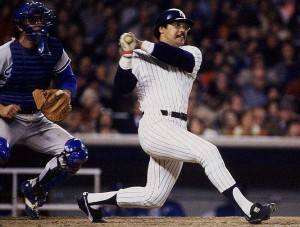
Reggie Jackson's play in the post season earned him the nickname "Mr. October."
You can debate whether or not there’s such a thing as “clutch” hitting. Scoring runs in the first inning is just as important as scoring runs in the ninth inning, right? Does the process of securing a hit change dramatically as the situation changes dramatically? Should we completely ignore the human elements of emotion, concentration and focus, each of which may fluctuate depending on the person in the batter’s box?
The following players (five hitters, five pitchers), for whatever reason, hit and pitched extremely well during the postseason, a period of time when the margin for error — and patience for under performing — is at a minimum.
1. Babe Ruth
He’s the greatest for a reason. As a pitcher in the postseason, Ruth boasts a microscopic 0.87 ERA in 31 innings pitched, a shutout and a 3-0 record. His best performance came in a 14-inning, complete game win in Game 2 of the 1916 World Series. In both World Series in which he pitched, the Red Sox won (1916 over the Brooklyn Robins and 1918 over the Chicago Cubs). As a hitter, he amassed 15 home runs in 167 plate appearances, accumulating an impressive 1.211 OPS. In 1928, he hit .625 in a four-game sweep of the Cardinals, notably mashing three home runs in the series-clinching game.
2. Reggie Jackson
Mr. October kindly disagrees with the idea that clutch hitting doesn’t exist. He was the first player to win World Series MVP with two different teams (Athletics and Yankees), and was just the second player to hit three homeruns in a World Series game — that, as you probably know, came in the series-clinching Game 6 of the 1977 World Series versus the Dodgers. During the six games, he hit five home runs with a .450 average and 1.792 OPS. A year later, he led the Yankees to a repeat in a rematch, hitting a meager two home runs with a .391 average and 1.196 OPS. He hit 18 home runs during his postseason career. Read the rest of this entry →
Tags: Babe RuthBob Gibsoncurt schillingJohn SmoltzLou GehrigMariano RiveraReggie Jacksonworld series
Category
Baseball, Great Moments, Sports History, World Series
Posted on
August 31, 2011 by
Dean Hybl
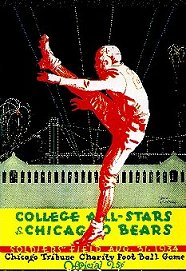
The first Chicago College All-Star Game was played on August 31, 1934.
It was 77 years ago today that nearly 80,000 people packed Soldier Field for the first game of what would become a popular forty year series of football games pitting the best of the recent college graduates against the defending NFL Champions.
The brainchild of Chicago Tribune Sports Editor Arch Ward, the first game was played on August 31, 1934 and though the game ended in a 0-0 tie, it set the stage for an annual exhibition that eventually drew more than 100,000 fans.
Many of the greatest players in college and NFL history were part of the series over the years and the game wasn’t always a walk-in-the-park for the NFL Champions against the young NFL rookies. In fact, two of the first three games in the series ended in a tie and in 1937 Sammy Baugh led the College All-Stars to their first victory in the series.
The game was played annually through 1976 when declining crowds and the reluctance of coaches to lose their star rookies for the beginning of training camp led to the end of the series.
However, what still remains is a legacy of classic games and memories of a time when NFL exhibition games did have value and meaning and newcomers could make an immediate impression against the best stars in the league.
For more memories from the Chicago College All-Star Games, check out this in depth article that was originally written for Sports Then and Now in 2009.
Tags: ChicagoChicago College All-Star GameNFL
Category
Football, Great Moments, NFL, Sports History
Posted on
August 16, 2011 by
Dean Hybl
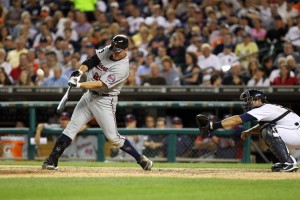
Jim Thome is the fifth player to reach 600 home runs in the last decade and eighth all-time.
In baseball the number of career home runs needed to reach baseball immortality used to be 500. Thanks to baseball’s “Steroid Era” and the sudden rise of sluggers eclipsing that mark, that magic number now appears to be 600 career homers. That club just got a little larger on Monday night as Jim Thome became the eighth player in baseball history to reach 600 career home runs.
Since becoming a full-time starter for the Cleveland Indians in 1994, Jim Thome has been one of the most prolific and consistent sluggers in baseball while leaving the headlines and accolades to others.
He eclipsed the 40 home run plateau six times and hit 52 in 2002, but never finished higher than fourth in the MVP balloting and earned only five trips to the All-Star game.
Because his greatest talent was hitting home runs during a time when that skill was no longer unique, Thome has often been pushed aside as a product of his time.
However, unlike many of the other sluggers of his era, even though his career started right about the time that performance enhancing drugs began to engulf baseball, there has never been any evidence or accusations linking Thome’s home run proficiency to use of a synthetic product.
Yet, it has taken him nearing the 600 home run plateau for many baseball fans to even acknowledge that Thome belongs in the Baseball Hall of Fame. Read the rest of this entry →
Tags: Baseball Home Run Leaderscleveland indiansJim ThomeMinnesota Twins
Category
Baseball, Great Moments, Sports History
Posted on
July 25, 2011 by
Dean Hybl
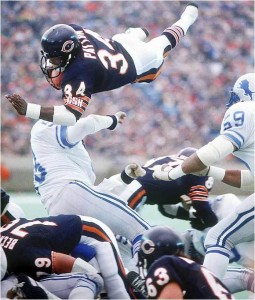
He didn't have a cape, but Walter Payton could leap over tall NFL players in a single bound.
The images of him flying through the air or high stepping across the end zone are so ingrained in the memories of football fans who had the pleasure of watching his amazing talents that it is hard to believe that it has been 24 years since Walter Payton completed his NFL career and nearly a dozen years since his premature passing.
On what would have been Payton’s 57th birthday (he was born on July 25, 1954 in Columbia, Mississippi), we remember the greatness of a football player who was simply sweet.
I know you hear it all the time, but God definitely broke the mold when he created Walter Payton.
Others are recognized as maybe being better NFL players, but I just don’t know that there was ever a better combination of desire, gracefulness, power and athleticism packed into a 5-foot-10 frame than the man they called “Sweetness.”
By all accounts, Payton never should have been as great as he was.
Given his physical stature, initial preference for playing the drums over playing football and that he played his college football at tiny Jackson State it is really quite amazing that Payton went on to achieve such lofty status.
However, heart and desire cannot be measured at a scouting combine and there is no question that Payton had those required tools in spades.
Payton’s career numbers: 16,726 rushing yards (second all-time), 21,264 yards from scrimmage (3rd), 125 touchdowns (11th) are beyond reproach, but his career was about so much more than mere statistics.
For more than a decade, Payton was the silent assassin of the NFL. His soft voice and quiet demeanor off the field masked his killer instinct on the field.
They also masked his reputation as a locker room prankster and cut-up. Read the rest of this entry →
Tags: chicago bearsNFLwalter payton
Category
Football, Great Moments, NFL, Sports History
Posted on
July 23, 2011 by
Jena Ellis
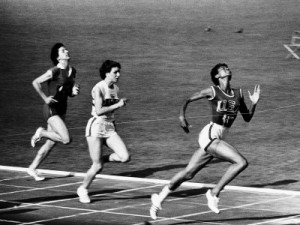
Wilma Rudolph was the first American woman to win three Gold Medals in a single Olympics.
America’s heartbreaking loss to Japan in the Women’s World Cup final, though painful, was hardly a setback for women’s sports in this country. During this summer, the world’s No. 1 team provided enough drama to captivate men and women from coast to coast, drawing large television audiences and even setting a Twitter record of 7,196 tweets per second. Hope Solo and Abby Wambach became household names and served as inspiration for girls who strive to play soccer and other sports at the highest levels. None of it would’ve happened, however, without the following milestones. Each one marked an important moment in not just women’s sports history, but sports history.
1. President Nixon makes Title IX a reality (1972)
Signed into law by the socially moderate President Nixon, Title IX specified that “No person in the United States shall, on the basis of sex, be excluded from participation in, be denied the benefits of, or be subjected to discrimination under any education program or activity receiving Federal financial assistance.” Participation in women’s sports has grown significantly in the decades following its passage, as a 2008 study indicated that women’s college athletics has expanded to 9,101 teams (8.65 per school).
2. Wilma Rudolph wins three gold medals (1960)
Women’s track and field became one of the Olympics’ flagship events thanks to Rudolph, who became the first American woman to secure three gold medals (100m, 200m, 4 x 100m relay) during the 1960 Summer Olympics in Rome. Dubbed “the fastest woman in history,” a worldwide audience was able to witness her blazing speed on television, enabling her popularity to soar. Her impact was especially felt in the US, where a demand for equality was just beginning to manifest.
3. Women’s soccer wins its second World Cup (1999)
This one was extra special because the US was the host country, allowing the women’s soccer team to demonstrate its talent before pro-American home crowds, interest that even surprised the players. Never before had America rallied behind a women’s team in such a manner — most people forgot about the gender distinction and milestones, and just rode the wave of patriotism to the final. That’s when, of course, Brandi Chastain memorably connected on the game-winning penalty kick, ripping off her jersey in exuberance. With 90,185 fans in attendance, it became the most-attended women’s sporting event in history. At the time, it garnered a remarkable 11.4 rating, the most-watched soccer game in US television history and one-tenth of a point higher than the average rating of that summer’s NBA Finals. Read the rest of this entry →
Tags: 1999 U.S. Women's Soccer TeamBillie Jean KingWilma RudolphWomen's Sports
Category
Great Moments, Sports History, Summer Olympics, Track & Field
Posted on
July 17, 2011 by
Dean Hybl
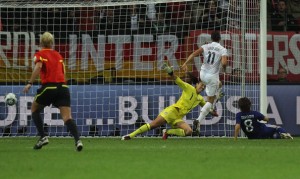
The Women's Soccer World Cup final was an exciting game that made fans forget about gender, at least for the day.
Had the United States Women’s Soccer Team held on to their second half and extra period leads in the 2011 Women’s World Cup there would probably have been dozens of articles written today about how the victory would change the culture for women’s sports and soccer in the United States. Because America is a country where most people generally give their loyalty to winners, most of those same writers are likely now writing about how women’s sports in general and specifically soccer can go back to their place on the back shelf of American sports interest.
I have been a fan of soccer since watching Pele and the New York Cosmos and then playing the sport as a youngster on some of the first youth soccer teams in my area in the late 1970s. However, even if the American women had won, one tournament wasn’t going to change the fact that soccer is a sport that Americans care about much like they do the primary Olympic sports. When national pride is on the line we care, but the rest of the time we don’t really care and never will.
I’m willing to bet if you walked the streets of just about any city or town in America and asked 50 people to name even one team from the MLS, most would look at you funny and ask “what is an MLS?” If you dared ask them about the WPS they would probably report you to the cops.
But while the result of the Women’s World Cup final may not have changed that fact, just the interest given to the game by the mainstream media does have an impact in another important way.
My seven-year-old daughter likes art, music and reading. There is absolutely no chance that she will be a professional athlete and though sports are on the television at our house almost continuously, she rarely has even the slightest interest.
However, twice in the last few months I have seen a spark in her eye about commercials for sporting events. The first was in early April when the NCAA Division I Women’s Basketball Final Four was being promoted. The second was this week in preparation for the Women’s World Cup final.
She sat and watched much of the women’s basketball Final Four with me and today though we were out and about during most of the game she navigated to the television when possible to see how the game was going and was genuinely interested when I would give reports while following the game on my phone.
I asked her this afternoon why she was interested in those games and she said it was because it isn’t that often that women’s sports are on television and she likes watching them.
Read the rest of this entry →
Tags: abby wambachwomen's soccerWorld Cup
Category
Great Moments, soccer, World Cup





